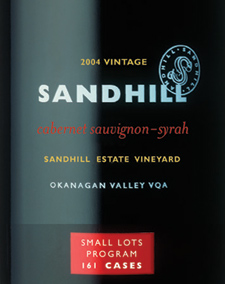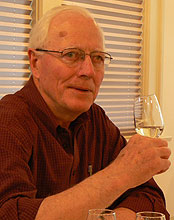

Sandhill
2004 Cabernet Sauvignon-Syrah - Small Lots, Sandhill Estate Vineyard(Okanagan Valley)
Only 161 cases of this wine were made, such a small volume one wonders why it did not just disappear into the other fine releases in the Small Lots program. The answer, presumably, is that this classic Australian-styled blend is just too tasty not to make. Aging the wine 22 months in new American oak also differentiates it from most other Small Lots wines excepttwo, which has almost as much Cabernet Sauvignon and also is aged in American wood. The Syrah makes the difference, bringing leathery, gamey flavours, along with a whiff of pepper.
This dark wine has aromas of plums, black cherries, vanilla and chocolate, telegraphing the flavour profile as well. This is a big plummy red with firm but ripe tannins. The wine takes a littler while to open up, an indication that these bottles could benefit from a few more years in the cellar.
Sadly, perhaps, most will have ended up with restaurants and will be happy consumed with good steaks long before the next vintage comes along. 88 points.
Reviewed March 14, 2007 by John Schreiner.
Other reviewed wines from Sandhill
|
Sandhill 2005 Barbera - Small Lots, Sandhill Estate Vineyard (Okanagan Valley)John Schreiner 3/28/2008 |
|
Sandhill 2005 Sangiovese - Small Lots, Sandhill Estate Vineyard (Okanagan Valley)John Schreiner 3/28/2008 |
|
Sandhill 2005 Petit Verdot - Small Lots, Phantom Creek Vineyard (Okanagan Valley)John Schreiner 2/22/2008 |
|
Sandhill 2004 Sangiovese - Small Lots, Sandhill Estate Vineyard (Okanagan Valley)John Schreiner 4/5/2007 |
|
Sandhill 2004 Petit Verdot - Small Lots, Phantom Creek Vineyard (Okanagan Valley)John Schreiner 2/6/2007 |
The Wine
Winery: Sandhill |
The Reviewer John Schreiner
John Schreiner
John Schreiner has been covering the wines of British Columbia for the past 30 years and has written 10 books on the wines of Canada and BC. He has judged at major competitions and is currently a panel member for the Lieutenant Governor’s Awards of Excellence in Wine. Both as a judge and as a wine critic, he approaches each wine not to find fault, but to find excellence. That he now finds the latter more often than the former testifies to the dramatic improvement shown by BC winemaking in the past decade. |




























